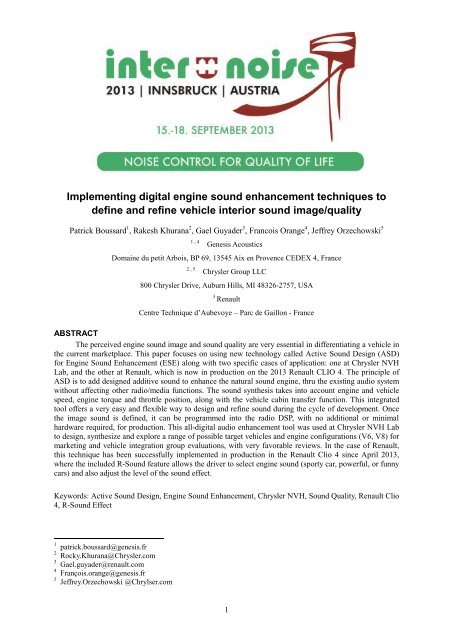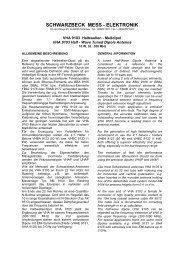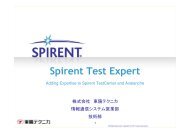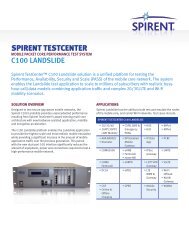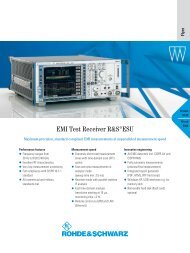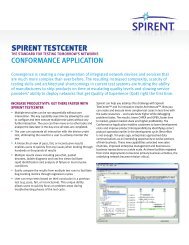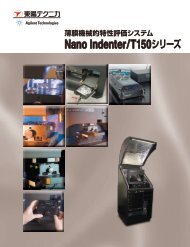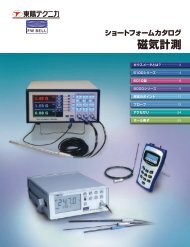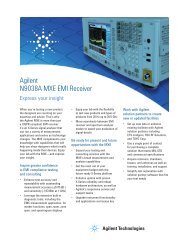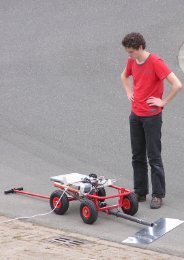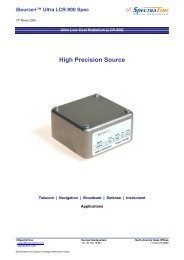Implementing digital engine sound enhancement techniques to ...
Implementing digital engine sound enhancement techniques to ...
Implementing digital engine sound enhancement techniques to ...
You also want an ePaper? Increase the reach of your titles
YUMPU automatically turns print PDFs into web optimized ePapers that Google loves.
Figure 2 - Design & Test Process with LEA & ASD (Active Sound Design) ModulesFigure 3 - Example of how target orders are enhanced within ASD Module3. Chrysler experience of <strong>engine</strong> <strong>sound</strong> design3.1 Background/ChallengeThe Interior <strong>sound</strong> signature of the new proposed sporty variant of a production vehicle did notmeet the target image <strong>sound</strong> expected in the sport segment. Chrysler desired a more competitive andsporty <strong>sound</strong> <strong>to</strong> differentiate this product in the marketplace. Since the vehicle architecture wasalready in existence, <strong>sound</strong> <strong>enhancement</strong> solutions were limited <strong>to</strong> re-tuning induction and exhaust.Exhaust tuning options were very limited since the vehicle was already close <strong>to</strong> the legal pass-byrequirements. Designing/fabricating and testing a new exhaust tuning code was beyond the allocatedbudget, and outside the scope for timing. Opportunities explored for induction tuning did not resultin a major <strong>sound</strong> quality improvement.4
Figure 4 - Comparison of Base Vs. Base Vehicle w/V8 <strong>sound</strong> <strong>enhancement</strong>Once the desired <strong>sound</strong> profile is finalized, the resulting BOX file is ready for productionimplementation. This is done by embedding the corresponding run-time script file within the DSP ofthe Audio Processor.3.5 Results of Chrysler experienceEngineering <strong>sound</strong> <strong>enhancement</strong> technology via the existing audio system is a very powerful,effective and low-risk solution <strong>to</strong> achieve the desired character in a vehicle. Besides being a verylow-cost solution, it is much quicker <strong>to</strong> implement than redesigning/retuning/modifying induction,exhaust and other hardware, which carries the risk of degrading functionality, pass-by requirements,etc.In addition <strong>to</strong> just basic <strong>sound</strong> enrichment, it can easily be used in a number of otherareas/applications including:- Enabling additional modes on vehicle (Super-Sport/ Sport / Eco, etc.)- Cylinder De-activation (add back normal firing orders)- Cold Engine Mode (mask un-desired content)- Electric Vehicle (add normal/sporty driving modes <strong>to</strong> replicate a firing <strong>engine</strong>)- HEV switching <strong>to</strong> electric mode (mask transient)- Towing (mask un-desired content)- Exterior Noise (add exterior weather-resistant speakers <strong>to</strong> enhance exhaust note)- Diagnostic message relay (Convey diagnostic messages from the CAN Bus)4. Renault R-Sound effect experience with CLIO4.1 Feature descriptionRenault’s R-Sound Effect feature is embedded in the new 2013 CLIO 4 multimedia system. I<strong>to</strong>ffers the Driver a choice from various pre-programmed <strong>engine</strong> <strong>sound</strong>s via the Man Machinegraphical Interface (MMI) illustrated in Figure 5. Shown are 3 example profiles (of 6 available) thatillustrate different <strong>sound</strong> designs based on existing, theoretical and futuristic products.6
Figure 5 - Man Machine graphical Interface (MMI) of R-<strong>sound</strong> Effect4.2 Sound design processThe Renault team clearly identifies 3 types of <strong>sound</strong> design processes for au<strong>to</strong>motive <strong>sound</strong>s.- First one based on existing vehicles and <strong>engine</strong>s- Second one based on expert’s knowledge and numerical simulations- Third one based on product intentionsThe main process is based on recording, analyzing, and then synthesizing an existing car and thenusing it <strong>to</strong> propose designed <strong>sound</strong>s. In this process, we focus on recognition of <strong>sound</strong> and accept afew modifications in order <strong>to</strong> keep it compatible with a majority of audio systems. The frequencycomponents in the final <strong>sound</strong> are similar <strong>to</strong> the recorded <strong>sound</strong>.This process leads <strong>to</strong> “rich components” as shown in figure 6. Rich component means that thespectrum is composed of many orders and each order level varies very quickly with <strong>engine</strong> speed.Figure 6 - typical order analysis of <strong>sound</strong> obtained by measurementThe second <strong>sound</strong> design approach is based on theoretical harmonic creation. Engine expertsknow which <strong>engine</strong> order is generated by a specific architecture (V6, V8, L4 …). We use numericalsimulation <strong>to</strong> calculate each <strong>engine</strong> order level for each RPM, from mobile masses efforts andcombustion force. This approach leads <strong>to</strong> “pure component” spectrums as figure 7, each order levelis varying slowly as RPM changes and it presents less that 10 or 15 orders (more is possible forspecific <strong>engine</strong>s). In our case we use this kind of <strong>sound</strong> design process <strong>to</strong> propose a mo<strong>to</strong>rcycle<strong>sound</strong>; as Renault is not a mo<strong>to</strong>rcycle manufacturer so we decided <strong>to</strong> propose a theoretical <strong>sound</strong>.Figure 7 - typical order analysis of <strong>sound</strong> obtained by an expert approachThe third <strong>sound</strong> design strategy is based on product intention and leads <strong>to</strong> a pure <strong>sound</strong> creation.We used this method <strong>to</strong> propose a specific <strong>sound</strong> for the space shuttle or a UFO that is clearlyimpossible <strong>to</strong> measure. We don’t have any in-house expert <strong>to</strong> design this <strong>sound</strong>, and the unique7
guideline is <strong>to</strong> design the <strong>sound</strong> of a UFO as the cus<strong>to</strong>mer would expect <strong>to</strong> drive it. This process issimilar <strong>to</strong> VSP <strong>sound</strong> designed for Electrical Vehicle where constraints lead <strong>to</strong> imagined <strong>sound</strong>s fromwords or intentions [10] [11]. The creation of this kind of <strong>sound</strong> faces multiple difficulties; one ofthe most important is that the <strong>sound</strong> interpretation for each person leads <strong>to</strong> different aesthetic choicesand cultural aspects being also not insignificant.All these 3 processes are very different, and graphically represented in figure 8.Need analysis <strong>to</strong>olsNeed simulation <strong>to</strong>olsClio V6, analyze<strong>sound</strong> design processObject axeExistingMo<strong>to</strong>cycle, ExpertIn mind<strong>sound</strong> design processAnalyseCreationSound axeVery Old Car ?Out of mindUnrealisticUFO, Product <strong>sound</strong>design processNeed creation <strong>to</strong>olsFigure 8 – Sound/Object 2D graph4.3 Sound choiceDuring R-<strong>sound</strong> development a lot of proposed <strong>sound</strong>s are generated with suggestions from manyemployees. This activity is treated internally more like a “<strong>sound</strong> design championship”. Since all theproposed <strong>sound</strong>s cannot be implemented, a few select <strong>sound</strong>s are shortlisted via a jury panel <strong>to</strong> beimplemented in the MMI.The choice is probably the most difficult stage of the process and in addition <strong>to</strong> acoustic andtechnical constraints, trademark laws have <strong>to</strong> be considered. We can only use images of Renaultgroup vehicles and unbranded vehicles (as UFO or unbranded mo<strong>to</strong>rcycle). Then for recent vehiclesthe link between image and <strong>sound</strong> is driven by the existing <strong>sound</strong> (as Clio V6) and the choice isreduced <strong>to</strong> the binary possibility: do we propose this vehicle <strong>to</strong> our cus<strong>to</strong>mer, yes or no?The choice is more difficult for simulated <strong>sound</strong>s. A jury was used <strong>to</strong> achieve the final list of<strong>sound</strong>s and images, and consisted of style (graphical design), marketing, vehicle project leader,product definition, cus<strong>to</strong>mer satisfaction and 2 acousticians (the people who proposed the <strong>sound</strong>swere excluded from this jury).The choice for futuristic <strong>sound</strong> is even more difficult. The first question is whether <strong>to</strong> propose aUFO <strong>sound</strong> or not? Experts who work on <strong>engine</strong> <strong>sound</strong> for a long time are clearly against this kind of“non physical <strong>sound</strong>”, but marketing and designers accept this as an amusing approach <strong>to</strong>tally inphase with the R-Sound effect product. When we decided <strong>to</strong> propose an UFO in our MMI thequestion was: what should be the <strong>sound</strong> of an UFO? Then the <strong>sound</strong> designer team proposed <strong>sound</strong>sand let the jury picked the final <strong>sound</strong>.4.4 Sounds ValidationValidating <strong>sound</strong>s is quite easy with appropriate <strong>to</strong>ols, and it’s clear that it is impossible <strong>to</strong>8
validate this kind of <strong>sound</strong> with a standard jury testing in a labora<strong>to</strong>ry. The validation must bedynamic, in car and with different levels. We ask ourselves the following questions:- Sound quality level, is the <strong>sound</strong> pleasant? Is the <strong>sound</strong> coherent with image? (recognition)- Is the <strong>sound</strong> able <strong>to</strong> provide additional sensations? (clearly different with original vehicle<strong>sound</strong> and audible)- Is the <strong>sound</strong> adapted <strong>to</strong> every usage of the vehicle?- We also consider that this kind of <strong>enhancement</strong> must respect security aspects, and we checkthat every <strong>sound</strong> leads <strong>to</strong> enhance pleasure for the lowest speeds. Thus we reduce the level of<strong>enhancement</strong> as the speed vehicle increase.It’s important <strong>to</strong> notice that the validation and fine tuning of each <strong>sound</strong> is an iterative processwith in vehicle test driving, measurement and new design until achievement of each validationparameter. The process has been meanly repeated three times for each <strong>sound</strong> <strong>to</strong> get the right <strong>sound</strong>.After that, the porting and implementation was done with a car audio supplier and the Clio 4 with the6 different new <strong>sound</strong>s is now available on the market since 2013.5. CONCLUSIONWe explored a complete Sound Design of Engine Sound process from <strong>sound</strong> recording <strong>to</strong><strong>sound</strong> generation by using the audio stereo system. This process, based on <strong>digital</strong> signal processing,has the following advantages: Cost: The algorithm doesn’t require a lot of computation power. It’s much cheaper than amechanical solution. Freedom: The <strong>sound</strong> designer has no mechanical constraint; the <strong>sound</strong> can be completelynew. Flexibility: The algorithm and the data set of <strong>sound</strong> synthesis can be uploaded at the endof the car’s project life. The <strong>sound</strong> design can be created in parallel with themechanical design. The same <strong>sound</strong> design can also be applied <strong>to</strong> different vehicles. Choice: It’s possible <strong>to</strong> give the choice <strong>to</strong> the driver among several data sets for different<strong>sound</strong> designs. Adaptation: The <strong>sound</strong> design can be adapted <strong>to</strong> different drivers’ preferences. The <strong>sound</strong>design can also have other parameters <strong>to</strong> reduce the <strong>engine</strong> <strong>sound</strong> <strong>enhancement</strong>, forinstance if the driver decides <strong>to</strong> listen <strong>to</strong> music on the car audio system. Environment: The <strong>sound</strong> design by embedded <strong>sound</strong> synthesis is a chip only weighing afew ounces, easily recyclable, with less CO2 <strong>to</strong> manufacture than a mechanical solution.In addition, this solution doesn’t produce any noise annoyance outside of the car. Performance: Because it’s very small and very light, performances like acceleration arebetter. Fuel consumption and CO2 emission are also lower than with a mechanicalsolution.Product development experience at Chrysler Group LLC in USA and implementation experienceat Renault in France validates the ease and flexibility of <strong>sound</strong> design, audio playback andimplementation in-vehicle. In both cases, feedback from the hands-on development experience hasbeen over-whelming positive in achieving the final goal of enhancing the driver’s audio experience.This technology appears <strong>to</strong> be ready for prime-time production implementation, with the biggestchallenge being on how <strong>to</strong> market this feature with potential vehicle buyers in marketplace.6. REFERENCES[1] Emilie Poirson, Jean-François Petiot, Florent Richard « A method for perceptual evaluationof products by naive subjects - application <strong>to</strong> car <strong>engine</strong> <strong>sound</strong>s” published in "International Journalof Industrial Ergonomics 40, 5 (2010) 504-516"[2] Florent Richard, Vincent Roussarie “ Design de l’ambiance sonore d’un véhicule au<strong>to</strong>mobile– Méthode et outil pour le contrôle de la coloration moteur” published in "Acoustique et TechniqueSpecial “Design Sonore” n°41 (2005) 16--19"[3] N. Kubo “Types of Car Sound Quality categorized by Frequency Dynamics”, ICSV16,Krakow9
[4] B. Le Nindre “ Typage sonore identitaire : le cas du véhicule sportif “ published in"Acoustique et Technique Special “Design Sonore” n°41 (2005) 20-23"[5] Leo L. Beranek, “Criteria for noise and vibration in communities, buildings, and vehicles,”Chap. 17 in Noise and Vibration Control Engineering Principles and Applications, edited by Leo L.Beranek and Istvan L. Ver (Wiley, New York, 1992).[6] Bernard Widrow and Samuel D. Steams, Adaptive Signal Processing (Prentice-Hall,Englewood Cliffs, New Jersey, 1985).[7] T. F. W. Emble<strong>to</strong>n, “Tu<strong>to</strong>rial on <strong>sound</strong> propagation outdoors,” J. Acoust. Soc. Am., 100(7),31-48 (1996).[8] M. Stinson and G. Daigle, “Meteorological measurements for use in <strong>sound</strong> propagationcalculations,” Proc. 7th Long Range Sound Propagation, 137-147 (1996).[9] M. Nishimura, M. Kondo, K. Iwamo<strong>to</strong> and Y. Tsujimo<strong>to</strong>, “Active attenuation of impulsivenoise from a railway tunnel exit,” Proc. INTER-NOISE 94, 1383-1388 (1994).[10] Le Nindre B., Guyader G., “EV- <strong>sound</strong> quality: cus<strong>to</strong>mer expectations and fears - crucialNVH stakes”, Proceedings of SIA conference (Société des Ingénieurs de l’Au<strong>to</strong>mobile), Saint -Ouen,France, 2010.[11] N. Misdariis, A. Cera, E. Levallois, C. Locqueteau, Do electric cars have <strong>to</strong> make noise? Anemblematic opportunity for designing <strong>sound</strong>s and <strong>sound</strong>scapes, Proceedings ACOUSTICS 2012 ,Paris , France , 201210


